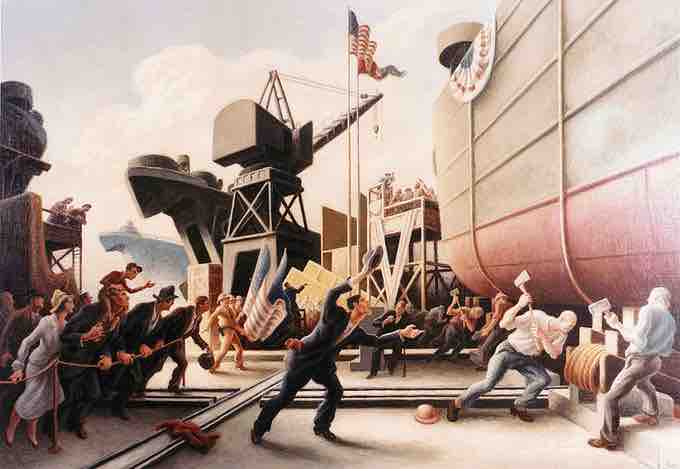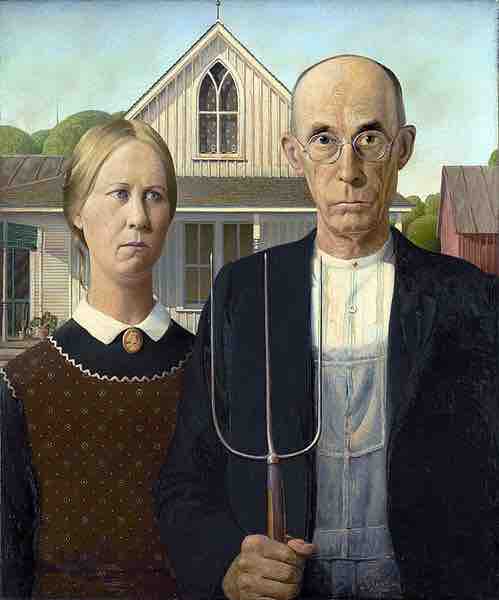Regionalism, also known as American scene painting, refers to a naturalist style of painting that was prevalent during the 1920s through the 1950s in the United States. After World War I, many American artists rejected the modern trends emanating from the Armory Show and European influences, choosing instead to adopt an academic realism to depict American rural scenes.
Partly due to the Great Depression, Regionalism became one of the dominant art movements in America in the 1930s (the other being Social Realism). At the time, the United States was still a heavily agricultural nation with a much smaller portion of its population living in industrial cities such as New York City or Chicago. A debate between abstraction versus realism had been ongoing since the 1913 Armory Show, and this continued throughout the 1930s between Regionalism, Social Realism, and Abstract art. By the 1940s this debate had evolved into two "camps" that were divided geographically and politically: the Regionalists and the Social Realists who primarily lived in rural areas and whose work addressed social, economic and political issues; and the Abstract artists who primarily lived in New York City and embraced Modernism. Regionalism's eventual loss of status in the art world is mainly a result of the ultimate triumph of Abstract expressionism, when Modernist critics gained power in the 1940s.
Using a realist approach, Regionalist artists shunned city life and its rapidly developing technological advances to create scenes of rural life. In Grant Wood's pamphlet Revolt Against the City, published in Iowa City, 1935, he asserts that American artists and buyers of art were no longer looking to Parisian culture for subject matter and style. Wood wrote that Regional artists interpret physiography, industry, and psychology of their hometown, and that the competition of these preceding elements creates American culture. He wrote that the lure of the city was gone, and hoped that art of the widely diffused "whole people" would prevail.
Grant Wood, The Midnight Ride of Paul Revere, 1931
This painting exemplifies a typical Regionalist depiction of small town America.
During the Great Depression of the 1930s, Regionalist art was widely appreciated for its reassuring images of the American heartland. Much of the work conveyed a sense of nationalism and romanticism in depictions of everyday American life. During the 1930s, these artists documented and depicted American small towns and rural landscapes, as well as cities; the works which stress local and small-town themes are often called "American Regionalism", and those depicting urban scenes, with political and social consciousness, are called "Social Realism". Some artists depicted images as a way to return to a simpler time away from industrialization, whereas others sought to make a political statement and lent their art to revolutionary and radical causes.

Thomas Hart Benton - Cut the Line
This 1944 artwork "Cut the Line" shows the launch of a Tank Landing Ship (LST). Benton is considered by many art critics to be the quintessential American artist of the 20th Century, and during World War II was commissioned by Abbott Laboratories to produce artworks about the Navy.
Regionalist style was at its height from 1930 to 1935, and is best-known through the so-called "Regionalist Triumvirate" of Grant Wood in Iowa, Thomas Hart Benton in Missouri , and John Steuart Curry in Kansas. Other artists of the movement include John Rogers Cox, Alexandre Hogue, Dale Nichols, and William S. Schwartz. Many artists involved in the movement studied with or under Benton at the Kansas City Art Institute (KCAI), such as John Stockton de Martelly, Frederic James and Pat Potucek.

Grant Wood - "American Gothic"
Grant Wood's best known work is his 1930 painting American Gothic, which is also one of the most famous paintings in American art, and one of the few images to reach the status of universally recognized cultural icon, comparable to Leonardo da Vinci's Mona Lisa and Edvard Munch's The Scream.